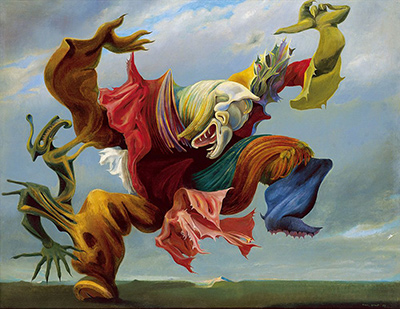Max Ernst, German water-colourist and sculptor was one of the prominent promoters of ludicrousness in art and a discoverer of the Automatism programme of Surrealism. He was an enfranchised resident of both the United States and France.
Ernst was more interested in psychoanalysis and philosophy, but he abandoned them for the portrait. Just after servicing the German army in World War I, Ernst was transformed into a pessimistic fine art movement and fashioned a group of Dada artistes in Cologne. Ernst later relocated to Paris, where he turned out to be an instituting member of the Surrealists. To inspire the flow of metaphors from his insensible mind, Ernst inaugurated the techniques of frottage and decalcomania to envisage the unintended patterns and qualities ensuing from these techniques.
Among the highly appreciated paintings, the triumph of surrealism has been praised worldwide for having amazing features. The Triumph of Surrealism was splattered by Max Ernst in the year of 1937. The portrait was initially called the Angel of Fireside and Home but it was later retitled by Ernst. Ernst generated this portrait for the account global du surrealism which occurred at the Galleria de Beaux-Arts in the Paris.
This watercolour was enthused from political measures. He splattered it shortly after the conquest of the Spanish Antimonarchists in the Spanish Domestic Battle. Ernst's aim was to illustrate the commotion that was disseminated all over Europe and the collapse that totalitarianism brought. Ernst accustomed the designation of this portrait to assist in inducing a sagacity of chaos and demolition. He was influenced by Giorgio de Chirico, the Arnold Bocklin and Max Stirner who are known for their amazing artwork.
The technique utilised by Max Ernst was oil on canvas as it’s the best technique known worldwide for bringing out the perfect paintings ever so if you need the perfect portrait, oil on canvas is all you need. Oil canvas involves utilising a medium comprising of tints adjourned in drying oils. The owing capability with which union of colour is realised brands it exceptional amongst liquefied painting mediums; at the same time, agreeable linear dealing and crunchy effects are straightforwardly obtained. Impervious, crystal clear, and luminous painting altogether tall tale in its assortment, and it is incomparable for the textural discrepancy. Oil painting colours are prepared by fraternizing dry powder pigments with carefully chosen polished linseed oil to a firm adhesive uniformity and grating it by sturdy friction as the steadiness of colour is important.




